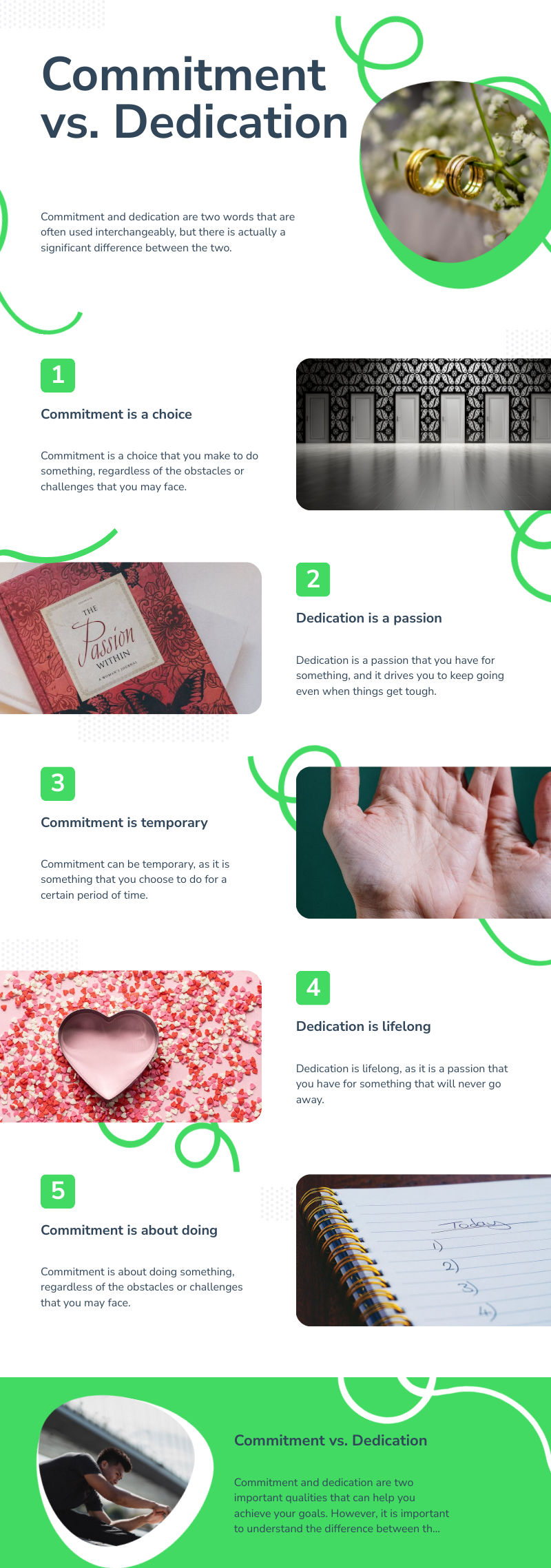Commitment is intent for long-term relationships/goals, while dedication is active effort to improve quality/benefit. Both vital for success.
Did you know that commitment and dedication can make or break your success in life? Understanding the differences between these two concepts is crucial for achieving personal and professional goals. Whether you’re striving for a lasting relationship, excelling in the workplace, or pursuing your passions, commitment and dedication play a vital role in your journey to success.
Key Takeaways:
- Commitment and dedication are distinct concepts that have a significant impact on personal and professional success.
- Commitment refers to the intention to maintain a long-term relationship or achieve a goal.
- Dedication represents the desire to improve the quality of a relationship or engage in behaviors that benefit a goal.
- Understanding commitment and dedication can enhance decision-making and foster a strong sense of commitment.
- Commitment and dedication are essential in relationships, workplaces, and personal endeavors.
The Role of Commitment in Relationships

In romantic relationships, commitment is like the glue that keeps partners together. It means deciding to stay with someone for the long haul, even when things get tough. Think of commitment as a promise to stick by each other, no matter what happens.
Researchers have theories to understand commitment. One theory says commitment grows when partners feel their lives are connected, and what one person does affects the other. Another theory talks about satisfaction, meaning how happy and content you feel in the relationship. It also mentions investment, like the time and effort you put into making the relationship work. And there’s a consideration of alternatives, or other people you could be with. The more satisfied, invested, and lacking other options you are, the stronger your commitment.
To make commitment even stronger, things like living together, having similar goals, sharing values, and talking openly can help build trust and make the relationship solid.
The Dynamics of Commitment: Dedication and Constraint

When it comes to commitment, understanding its dynamics can provide valuable insights into how it influences relationships. The Stanley and Markman model offers a framework that explores commitment through the lens of dedication and constraint.
Dedication: Improving the Relationship
Dedication encompasses the desire to enhance the quality of a relationship and engage in behaviors that benefit both partners. It reflects a personal commitment to investing time, effort, and emotional energy to foster growth and strengthen the bond. This type of commitment involves going beyond the bare minimum and actively seeking opportunities to nurture the relationship.
In a romantic partnership, dedication may involve acts of kindness, demonstrating love and support, and making sacrifices for the well-being of the relationship. For example, planning surprise dates, showing empathy during challenging times, and encouraging personal and professional growth can all be expressions of dedication.
Constraint: External and Internal Forces
While dedication reflects a personal choice to invest in a relationship, constraint refers to external or internal factors that limit individuals’ options to end the relationship. These constraints can take various forms, such as financial interdependence, social obligations, or personal beliefs. Constraint acts as a stabilizing force that keeps individuals committed in the absence of dedication alone.
An external constraint could be the presence of children, shared assets, or legal commitments, which may make it more difficult or costly to end the relationship. Internal constraints, on the other hand, could be emotional attachment, moral values, or religious beliefs that create an internal commitment to preserving the relationship.

The Interplay of Dedication and Constraint
Both dedication and constraint interplay to shape commitment levels within a relationship. While dedication enhances the quality and satisfaction of the relationship, constraint provides stability and limits alternative options. Understanding this interplay can help individuals evaluate their commitment dynamics and make informed choices.
| Dedication | Constraint |
|---|---|
| Desire to improve relationship | External or internal limitations on ending the relationship |
| Acting in ways that benefit both partners | Financial, social, or moral obligations |
| Investment of time, effort, and emotional energy | Emotional attachment or personal beliefs |
By understanding the dynamics behind dedication and constraint, individuals can navigate their commitment levels, cultivate a strong foundation in relationships, and foster long-lasting and fulfilling connections.
Commitment in the Workplace
Commitment at work means how much employees care about their job and the goals of the company. It’s like being excited and feeling responsible for what you do at work. This commitment is super important because it helps make employees happy, makes them work better, and helps the company achieve its goals.
When employees are really committed, they do more than just what their job says. They take charge, work hard, and help the whole team succeed. This positive attitude also makes the workplace a happy and creative space. But if employees aren’t committed, they might not care much, which can lead to less work getting done, and everyone feeling a bit unhappy. So, it’s a big deal for companies to make sure their employees stay excited and committed to their work.
The Definition of Work Commitment
Work commitment can be defined as:
- The level of dedication and loyalty employees have towards their work and the organization
- The sense of responsibility and ownership employees feel towards their tasks and responsibilities
- The alignment between employee values and organizational goals
A high level of work commitment is characterized by employees who are motivated, engaged, and willing to put in their best effort to achieve both personal and organizational success. These individuals are enthusiastic about their work, take pride in their contributions, and are driven by a sense of purpose.
On the other hand, low work commitment may manifest in employees who are disinterested, unmotivated, and lack a sense of responsibility towards their work. This can result in decreased productivity, higher turnover rates, and a negative impact on overall organizational performance.
The Impact of Work Commitment
Work commitment has a profound impact on both employee satisfaction and organizational success. When employees are committed to their work, they are more likely to:
- Take initiative and proactively seek opportunities for growth and development
- Embrace organizational goals and actively contribute towards achieving them
- Display resilience and perseverance during challenging times
- Collaborate effectively with colleagues and foster a supportive work environment
- Continuously strive for excellence and deliver high-quality work
In turn, these behaviors drive employee satisfaction, increase productivity, and contribute to the overall success of the organization. Employees who are committed to their work are also more likely to experience greater job satisfaction, leading to higher retention rates and a positive work culture.
Improving Work Commitment
Organizations can take several steps to improve work commitment among their employees:
- Establish clear organizational goals and communicate them effectively
- Provide opportunities for employee input and involvement in decision-making processes
- Recognize and reward employee achievements and contributions
- Promote a positive work environment that fosters collaboration and teamwork
- Offer professional development opportunities and support employee growth
- Encourage open, transparent communication and provide regular feedback
By prioritizing work commitment and implementing strategies to enhance it, organizations can create a culture that values employee engagement, fosters productivity, and drives long-term success.
The Importance of Work Commitment
Work commitment is super important for a company to do well. It means employees really care about their jobs and want the company to succeed. When workers are committed, they stay with the company for a long time, which is good because hiring and training new people costs money. Also, committed employees work harder, making the company more successful and productive.
Having a committed team also makes the workplace a happy and creative space. Everyone works together, supports each other, and feels like they belong. This teamwork and positive atmosphere help the company do better in a competitive world. So, companies should focus on making sure their employees are excited and committed to their work to be successful.
To illustrate the importance of work commitment, let’s take a look at the following data:
| Organizational Indicator | High Work Commitment | Low Work Commitment |
|---|---|---|
| Employee Retention | High | Low |
| Productivity | Increased | Decreased |
| Employee Satisfaction | High | Low |
Benefits of a Committed Team
A committed team is a valuable asset to any organization. Their dedication and passion contribute to various benefits that enhance overall performance and productivity. Let’s explore some of the key advantages a committed team brings:
Increased Productivity
One of the primary benefits of a committed team is the significant boost in productivity. Committed team members take their responsibilities seriously, striving to deliver their best work consistently. Their strong work ethic and drive to succeed inspire and motivate others, creating a positive work environment focused on achieving goals efficiently.
Target Achievement
When team members are committed to a shared vision and objective, they are more likely to work collaboratively and actively contribute towards target achievement. Committed teams understand the importance of setting and meeting targets, leveraging their collective skills and expertise to overcome challenges and deliver high-quality results.
Fun at Work
A committed team understands the significance of creating a fun and enjoyable work environment. They foster positive relationships, promote teamwork, and celebrate achievements, creating a lively atmosphere that encourages creativity, innovation, and employee morale. Fun at work not only improves job satisfaction but also boosts overall productivity.
Value Addition
Committed team members actively participate and share their ideas, providing valuable insights and contributing to the growth and success of the organization. Their dedication enables them to identify areas for improvement, implement innovative solutions, and add value to the team and the organization as a whole. Their constant pursuit of excellence aids in continuous improvement and fosters an environment of growth.
A committed team is an invaluable asset that drives productivity, achieves targets, fosters fun at work, and adds value through active participation and idea sharing. Organizations that cultivate and nurture committed teams reap the benefits of a highly motivated workforce that consistently delivers outstanding results.
Improving Work Commitment
Improving work commitment is essential for organizations to reach their full potential and achieve success. By implementing certain strategies and creating a conducive work environment, organizations can foster a strong sense of dedication and enthusiasm among their employees. Here are some key factors to consider:
Building Strong Teams
Strong teams are the foundation of a committed workforce. By bringing together individuals with complementary skills and diverse perspectives, organizations can create a collaborative and supportive work environment. This fosters a sense of belonging and encourages employees to invest their best efforts in achieving common goals.
Setting Clear Expectations
Clear expectations provide employees with a sense of direction and purpose. When employees understand what is expected of them and how their work contributes to the overall success of the organization, they are more likely to be committed and motivated. Managers should regularly communicate expectations and provide feedback to ensure alignment and accountability.
Promoting Transparency and Open Communication
Transparency and open communication are integral to fostering a culture of trust in the workplace. When employees feel that they have access to information and are encouraged to voice their opinions and concerns, they are more likely to be engaged and committed. Regular team meetings, open-door policies, and feedback channels can facilitate such transparency and communication.
Fostering Work Ethics
Strong work ethics are the backbone of a committed workforce. Organizations should emphasize the importance of professionalism, integrity, and diligence. By demonstrating and promoting ethical behavior at all levels, organizations can create a work environment that encourages employees to take pride in their work and maintain a high level of commitment.
Building Trust
Trust is essential for fostering commitment and loyalty among employees. Organizations should prioritize building trust by being fair, consistent, and transparent in their actions and decisions. Trust-building initiatives, such as team-building activities, mentorship programs, and recognition of employee contributions, can go a long way in strengthening trust within the organization.
Encouraging Innovation
Innovation is a key driver of commitment and growth. Organizations should create a culture that values and encourages innovative ideas and initiatives. By providing employees with the opportunity to explore new approaches, experiment, and contribute to the organization’s success, organizations can foster a sense of ownership and commitment.
Supporting Employee Growth
Investing in employee growth and development is crucial for enhancing commitment. Organizations should provide training, mentorship, and growth opportunities to help employees expand their skills and reach their full potential. This not only increases employee engagement and commitment but also contributes to the organization’s long-term success.
Providing Incentives for Exceptional Performance
Incentives play a significant role in motivating employees and reinforcing commitment. Organizations should design incentive programs that recognize and reward exceptional performance. This can range from financial incentives, such as bonuses and promotions, to non-financial rewards, such as recognition and opportunities for professional growth.
| Strategies to Improve Work Commitment | Benefits |
|---|---|
| Building strong teams | Enhanced collaboration and synergy |
| Setting clear expectations | Improved clarity and accountability |
| Promoting transparency and open communication | Increased trust and employee engagement |
| Fostering work ethics | Higher level of commitment and professionalism |
| Building trust | Enhanced loyalty and employee satisfaction |
| Encouraging innovation | Stimulated creativity and continuous improvement |
| Supporting employee growth | Increased employee motivation and retention |
| Providing incentives for exceptional performance | Rewards and recognition for outstanding achievements |
The Role of Teamwork in Work Commitment
Teamwork is super important for making people committed to their work. When employees work together and support each other, it helps them communicate better and get things done. Teamwork makes everyone feel like they belong, and this feeling of togetherness makes the whole company more successful.
Communication is a big part of teamwork. When team members talk openly and share ideas, it helps them solve problems and be more creative. Also, when people in a team interact and understand each other, they can use everyone’s strengths to do better work. Companies can even ask their teams for feedback to know how well they’re working together and make improvements. So, teamwork is like a secret weapon that makes the workplace awesome and successful.
| Benefits of Teamwork in Work Commitment |
|---|
| Increased productivity |
| Improved problem-solving and decision-making |
| Enhanced creativity and innovation |
| Reduced conflicts and improved collaboration |
| Higher employee satisfaction and motivation |
Cultivating a Culture of Trust and Transparency
Cultivating a culture of trust and transparency is crucial for enhancing work commitment in organizations. When employees feel valued, heard, and included in decision-making processes, they are more likely to be engaged, motivated, and committed to their work.
Trust in the Workplace
Trust is the foundation of any healthy work environment. When trust is present, employees feel comfortable sharing their ideas, concerns, and feedback, knowing that their opinions are respected and valued. Trust in the workplace fosters collaboration, encourages open communication, and creates a positive and supportive atmosphere.
Transparency
Transparency is key to building trust within an organization. By being transparent about goals, expectations, and decision-making processes, leaders can ensure that employees are well-informed and have a clear understanding of the company’s direction. Transparent communication helps to eliminate rumors, reduces uncertainty, and promotes a sense of fairness and equity.
Employee Participation
Employee participation is essential for fostering a culture of trust and transparency. By involving employees in decision-making processes, organizations show that they value their input and insights. This active involvement leads to increased employee engagement, commitment, and a sense of ownership in the company’s success.
Feedback
Regular feedback is a powerful tool for building trust and transparency in the workplace. By providing constructive feedback and recognizing employees’ achievements, organizations show that they care about their growth and development. Feedback also helps employees understand expectations, identify areas for improvement, and feel supported in their professional journey.
Work Culture Improvement
Improving work culture is an ongoing process that requires a concerted effort from leaders and employees alike. Building a culture of trust and transparency involves fostering open communication channels, encouraging collaboration and teamwork, promoting diversity and inclusion, and continuously seeking feedback to identify areas for improvement. By prioritizing work culture improvement, organizations can create an environment that nurtures work commitment, enhances employee satisfaction, and drives overall success.
| Benefits of a Culture of Trust and Transparency | |
|---|---|
| 1. Enhanced employee engagement and commitment | |
| 2. Increased productivity and innovation | |
| 3. Improved teamwork and collaboration | |
| 4. Higher employee satisfaction and retention | |
| 5. Better organizational communication and alignment |
Conclusion
In a nutshell, commitment and dedication are like the dynamic duo that greatly influence our lives. Commitment is about sticking to long-term plans or goals, while dedication is the energy and effort we put into making those commitments better.
It’s crucial to understand the fine line between commitment and dedication, especially for personal and professional growth. Knowing the unique traits of each helps us create a powerful mix of rock-solid commitment and wholehearted dedication. This not only boosts motivation and determination but also helps us stay strong and adaptable when facing challenges.
So, whether it’s in relationships, work, or personal goals, having both commitment and dedication is the winning formula. It allows us to build lasting relationships, contribute to big organizational goals, and achieve our dreams. Commitment keeps us focused, and dedication fuels our passion, creativity, and the pursuit of excellence in everything we do.
FAQ
What is the difference between commitment and dedication?
Commitment refers to the intention to maintain a long-term relationship or the level of enthusiasm and responsibility towards assigned tasks and organizational goals. Dedication, on the other hand, represents the desire to improve the quality of a relationship or engage in behaviors that benefit both partners or the organization.
How can commitment be understood in the context of romantic relationships?
Commitment in romantic relationships refers to the intention to maintain a long-term partnership. It is crucial for stabilizing attachment and ensuring relationship longevity. The concept of commitment is rooted in interdependence theory and the investment model, which highlight the importance of satisfaction, investment, and alternatives in fostering commitment.
What are the dynamics of commitment?
Commitment can be understood through the lens of dedication and constraint. Dedication represents the desire to improve the quality of a relationship and engage in behaviors that benefit both partners. Constraint refers to external or internal forces that limit the options of ending a relationship. Both dedication and constraint play a crucial role in shaping commitment levels.
What is work commitment?
Work commitment, also known as commitment to work, pertains to the level of enthusiasm and responsibility an employee has towards their assigned tasks and the overall goals, mission, and vision of the organization. It is essential for employee satisfaction, productivity, and overall organizational success.
Why is work commitment important?
Work commitment plays a crucial role in helping organizations achieve their goals and maintain their position in the market. It leads to higher employee retention, increased productivity, and a positive work atmosphere. Without a committed workforce, organizations may struggle to achieve long-term success.
What are the benefits of a committed team?
A committed team brings numerous benefits to an organization, including increased productivity, the ability to meet targets, a fun and innovative work environment, and value addition through active participation and idea sharing.
How can work commitment be improved?
Improving work commitment requires a multifaceted approach. Organizations should focus on building strong teams, setting clear expectations, promoting transparency and open communication, fostering work ethics, building trust, encouraging innovation, supporting employee growth, and providing incentives for exceptional performance.
What is the role of teamwork in work commitment?
Teamwork plays a vital role in fostering work commitment as it promotes effective communication, collaboration, and task completion. It helps employees feel supported and motivated, leading to increased productivity and a stronger commitment to the organization’s goals.
How can a culture of trust and transparency enhance work commitment?
Cultivating a culture of trust and transparency is essential for enhancing work commitment. Organizations should prioritize open and free communication, encourage employee participation, actively listen to feedback, and promote a work culture that values trust and transparency.
What are the key distinctions between commitment and dedication?
Commitment refers to the intention to maintain a long-term relationship or the level of enthusiasm and responsibility towards assigned tasks and organizational goals. Dedication, on the other hand, represents the desire to improve the quality of a relationship or engage in behaviors that benefit both partners or the organization.
Source Links
- https://www.ncbi.nlm.nih.gov/pmc/articles/PMC3039217/
- https://www.questionpro.com/blog/commitment-to-work/
- https://eightify.app/summary/philosophy-and-ethics/difference-between-promise-and-commitment
Image Credits
Featured Image By – storyset on Freepik
Image 2 By – 🌸♡💙♡🌸 Julita 🌸♡💙♡🌸 from Pixabay







